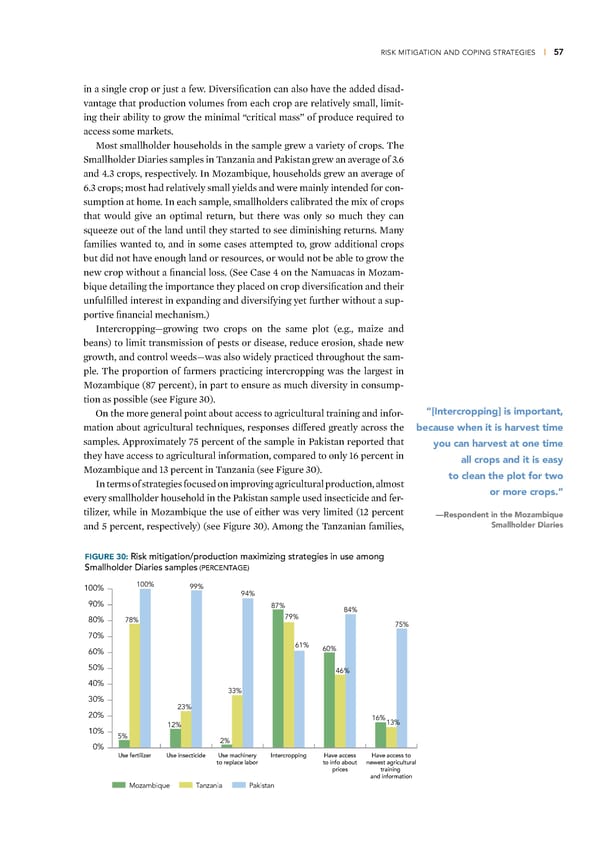RISK MITIGATION AND COPING STRATEGIES | 57 in a single crop or „ust a few ‰iversification can also have the added disad- vantage that production volumes from each crop are relatively small, limit- ing their ability to grow the minimal “critical mass” of produce reuired to access some marets –ost smallholder households in the sample grew a variety of crops Œhe Smallholder ‰iaries samples in Œan—ania and aistan grew an average of Ÿ¢ and “Ÿ crops, respectively €n –o—ambiue, households grew an average of ¢Ÿ crops most had relatively small yields and were mainly intended for con- sumption at home €n each sample, smallholders calibrated the mix of crops that would give an optimal return, but there was only so much they can suee—e out of the land until they started to see diminishing returns –any families wanted to, and in some cases attempted to, grow additional crops but did not have enough land or resources, or would not be able to grow the new crop without a financial loss (See †ase “ on the ˜amuacas in –o—am- biue detailing the importance they placed on crop diversification and their unfulfilled interest in expanding and diversifying yet further without a sup- portive financial mechanism) €ntercropping—growing two crops on the same plot (eg, mai—e and beans) to limit transmission of pests or disease, reduce erosion, shade new growth, and control weeds—was also widely practiced throughout the sam- ple Œhe proportion of farmers practicing intercropping was the largest in –o—ambiue (¡• percent), in part to ensure as much diversity in consump- tion as possible (see igure Ÿ’) ¦n the more general point about access to agricultural training and infor- “[Intercropping] is important, mation about agricultural techniues, responses differed greatly across the because when it is harvest time samples ˆpproximately •” percent of the sample in aistan reported that you can harvest at one time they have access to agricultural information, compared to only …¢ percent in all crops and it is easy –o—ambiue and …Ÿ percent in Œan—ania (see igure Ÿ’) to clean the plot for two €n terms of strategies focused on improving agricultural production, almost or more crops.” every smallholder household in the aistan sample used insecticide and fer- tili—er, while in –o—ambiue the use of either was very limited (…‘ percent —Respondent in the Mozambique and ” percent, respectively) (see igure Ÿ’) ˆmong the Œan—anian families, Smallholder Diaries FIGURE 30: Risk mitigation/production maximizing strategies in use among Smallholder Diaries samples (PERCENTAGE) 100% 100% 99% 94% 90% 87% 84% 80% 78% 79% 75% 70% 60% 61% 60% 50% 46% 40% 33% 30% 23% 20% 16% 12% 13% 10% 5% 0% 2% Use fertilizer Use insecticide Use machinery Intercropping Have access Have access to to replace labor to info about newest agricultural prices training and information Mozambique Tanzania Pakistan
 Financial Diaries with Smallholder Families Page 72 Page 74
Financial Diaries with Smallholder Families Page 72 Page 74